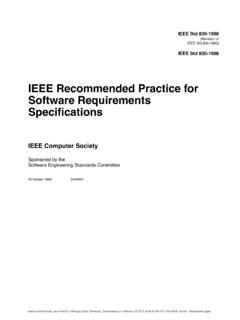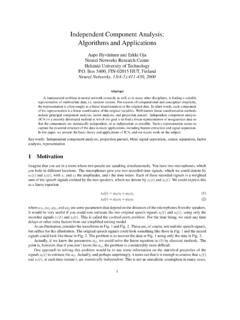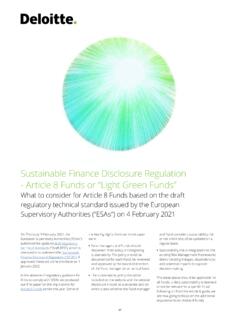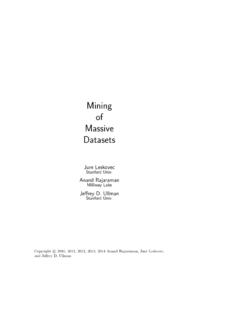Transcription of Classification of Fingerprints - Michigan State University
1 Classification of Fingerprints Sarat C. Dass Department of Statistics & Probability Fingerprint Classification Fingerprint Classification is a coarse level partitioning of a fingerprint database into smaller subsets. Fingerprint Classification reduces the search space of a large database: Determine the class of the query fingerprint. Then, only search templates with the same class as the query. Illustration: Inputs are the fingerprint impressions from 10 fingers of an individual. If size of the database is N and D is the number of classes, 10. Search space without Classification : N. Search space with Classification : (N/D)10. The Henry Classification System Henry (1900) made an extensive study of occurrence of Fingerprints and indexed them into 8 major classes. The 8 classes are shown above. The four different whorl classes can be combined into one class: Whorl (W).
2 The Henry Classification System (cont.). Left-loop (LL) Right-loop (RL) Whorl (W). Plain Arch (PA) Tented Arch (TA). The Henry system with five classes are shown above. The five classes can be reduced to four by combining the PA and TA. classes to form the Arch (A) class. The natural frequencies of W, L, R and A (A + T) are , , and The Henry Classification System (cont.). The five main classes differ in terms of the global flow patterns of the ridge curves. They also differ in terms of the number and locations of singular points in the fingerprint image. For example, LL exactly one core and one delta; the core is to the left of the delta, RL exactly one core and one delta; the core is to the right of the delta, W two cores and two deltas, PA no singular points, and TA one core and one delta; the delta is approximately directly below the core. Problems with the Henry Classification system: (i) non- uniform Classification proportions, and (ii) experts classify some fingerprint images into different Henry classes.
3 Examples of such Fingerprints are . TA and LL TA and RL TA and PA. Approaches for Fingerprint Classification Approaches based on singular points: Hong and Jain (1999), Karu and Jain (1996). Structure-based approaches such as using the orientation field and geometry of ridges: Cappelli et. al (2002), Chang &. Fan (2002), and Chong et. al (1997). Frequency-based approaches using Fourier spectrum: Jain et. al (1999). Syntactic or grammar-based: Moayer & Fu (1975,1976). Mathematical models: Silviu & Jain (2002), Dass & Jain (2004). Hybrid methods: Combination of at least two of the above approaches (Chang & Fan (2002) and Chong et. al (1997)). Singular point based approaches Karu and Jain (1996) classifies Fingerprints by detecting singular points in the fingerprint image. 1. The orientation field (flow direction of the ridges at each site in the fingerprint image) is extracted and smoothed.
4 2. Singular points are detected using the Poincare index. The Poincare index is computed by summing the changes in the angles of flow in a small circle around the test point. It is 0, - , , and 2 for regular, delta, core and double core points, respectively. Core Delta Input image Orientation Field Karu and Jain (1996), cont. The Classification procedure is: Get singular points Determine the number of core-delta pairs, N. 0 1 2. Loop or tented arch ? Arch Left-loop Right-loop Tented Arch Whorl Twin Loop 1. If N=1, consider the straight line joining the core and the delta. If N=2, consider the straight line joining the two cores. Call this line L. 2. For tented arch (whorl), the tangent direction of L is parallel to the local orientation values, but not so for loops (twin loop). Structure based approaches Structure based approaches use global characteristics of the ridges to determine the fingerprint class.
5 Chang & Fan (2002) use ridge distribution models to determine the class of the fingerprint. The 10 basic ridge patterns of Chang &. Fan are given on the left. Chang & Fan (2002). The fingerprint Classification procedure is based on the following steps: 1. For a given fingerprint image, an algorithm for extracting the ridges is developed. This algorithm takes into account (i) ridge bifurcations, and (ii) ridge fragmentations which are not endings. (i) Handling ridge bifurcations (i) Handling ridge fragmentations (a), true ridge endings (b). Chang & Fan (2002), cont. 2. Each extracted ridge is then classified into one of the 10 basic ridge patterns. Some examples of the Classification are: Chang & Fan (2002), cont. 3. The ridge distribution sequence is generated according to the picture below: Each of the 7 classes of the Henry system (except the accidental whorl) has a unique ridge distribution sequence associated to it.
6 Fingerprint images whose ridge distribution sequence cannot be determined are rejected. The accidental whorl class is a subset of the rejected images. Experimental results with the NIST4 database: with rejection rate for 7 classes, and for the 5 classes. Structural based approach - Chong & Ngee (1997). 1. The fingerprint Classification procedure is based on determining the global geometric structure of the extracted ridges using B- splines. 2. The B-splines provide a compact representation of the ridges and contain enough information to determine their geometric structure. 3. The main drawback of this method is that it was not tested on a large number of Fingerprints . Frequency based method Jain et. al (1999). 1. Frequency based approached covert the fingerprint image into the frequency space and perform the Classification in that space. 2. In Jain et. al (1999), Gabor filters at 16 different orientation values are applied to different sectors of the fingerprint image.
7 The Gabor coefficients form the feature for Classification . Fingerprint as Oriented Texture (a) Ridges in local region (b) Fourier spectrum of (a). Fingerprint Classification Algorithm A. K. Jain, S. Prabhakar and L. Hong, " A Multichannel Approach to Fingerprint Classification ", IEEE Transactions on PAMI, , , pp. 348-359, April 1999. 192-dimensional feature Vector Two-stage classifier K-nearest neighbor classifier Neural Network classifier Input Data A K-NN Classifier Neural Network Classifier Classification Results Five-class Classification error is 10%; error is 4% with rejection rate. Four-class Classification error is ; error is with rejection rate. Assigned Class 10%. True Class 9%. Whorl Right Loop Left Loop Arch Tented Arch 8%. 5-class Error Rate Whorl 366 16 8 4 1 7%. 6%. Right Loop 3 372 1 8 17 5%. Left Loop 4%. 6 0 364 6 7 3%. Arch 2 1 3 405 39 2%.
8 1%. Tented Arch 0 6 14 55 261 0%. 0% 7% 18% 31%. Reject Rate Approaches based on mathematical models . Silviu & Jain, 2002. Class-specific kernels are defined: the kernel for the whorl class is the unit circle, and for the other classes, the kernels are defined via splines. (a) (b) (c) (d). Figure: Kernels for (a) arch, (b) left-loop, (c) right-loop, and (d) whorl. For a fingerprint image, the energy functional is minimized to determine the best fitting kernel. Silviu & Jain (cont.). Results of the fitting algorithm: The best fitting kernel (the one that minimizes the energy functional below a certain threshold) is taken to be the class of the fingerprint image. Experimental results based on the NIST4 database yields a Classification accuracy of for the 4 class problem. Why Another Fingerprint Classifier ? Dass & Jain (2004). Limitations of the existing approaches: Ridges are subject to breaks and discontinuities due to noise Singular points may be missed in some fingerprint images Mathematical models are too rigid to represent all possible ridge variations Requirements of a fingerprint classifier: Robust detection of global ridge characteristics Classification invariance under affine transformations and mild non-linear deformations of the fingerprint Orientation Field Flow Curves Fingerprint Image Orientation Field Flow Curves Orientation field : local flow directions of the ridges and valleys Opposite flow directions are equivalent, angle [- /2, /2].
9 Orientation field flow curve (OFFC) is a curve whose tangent direction at each point is parallel to the orientation field direction This is not ridge tracing; OFFCs are pseudoridges Schematic Diagram of Classification Estimate Input Fingerprint Generate OFFCs Orientation Field Fingerprint class Determine Determine labels A, L, R, or W fingerprint class of OFFCs Estimation of Orientation Field*. A block-wise squared gradient approach with smoothness prior is used to obtain a smooth and robust estimate of orientation field Input image Orientation Field *S. C. Dass, Markov Random Field Models for Directional Field and Singularity extraction in Fingerprint Images , IEEE Transactions on Image Processing, October 2004. Generation of Orientation Field Flow Curves (OFFCs). Continuous Orientation Field Orientation Field Flow Curves From a starting point s0, an OFFC is generated by tracing the paths from s0 that is tangential to orientation field Detecting OFFC Type using Tangent Space Isometric Maps For each OFFC, we wish to determine whether it is a loop, arch or whorl The curve type can be identified using the tangent space isometric map of the OFFC.
10 Denote one end of the OFFC by se. Obtain the tangent plane at se, Te For an intermediate point s on the OFFC, obtain the tangent plane at s, Ts Rotate Te to match Ts; say, the angle of rotation is s The tangent space isometric map is the plot of cos( s). versus ds, the distance of s from se along the OFFC. Tangent Space Maps of Left-Loop Isometric map plot Isometric map plot 1 1. cos . cos . 0 0. 1 1. 10 20 30 40 50 60 70 80 90 100 10 20 30 40 50 60 70 80 90 100. j j Tangent Space Maps of Right-Loop Isometric map plot Isometric map plot 1 1. cos . cos . 0 0. 1 1. 10 20 30 40 50 60 70 80 90 100 20 40 60 80 100 120. j j Tangent Space Maps of Whorl Isometric map plot Isometric map plot 1 1. cos . cos . 0 0. 1 1. 20 40 60 80 100 120 140 160 180 200 20 40 60 80 100 120 140 160 180 200 220. j j Tangent Space Maps of Arch Isometric map plot Isometric map plot 1 1.









